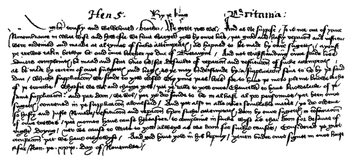- Chancery hand
-
 English chancery hand. Facsimile letter from Henry V of England, 1418.
English chancery hand. Facsimile letter from Henry V of England, 1418.
 Chancery cursive (Cancelleresca corsiva) hand. Papal Letter to Christian II of Denmark, 21 April 1518 (Royal Archives)
Chancery cursive (Cancelleresca corsiva) hand. Papal Letter to Christian II of Denmark, 21 April 1518 (Royal Archives) This article is about the European style of writing. For the Chinese style of calligraphy, see Clerical script.
This article is about the European style of writing. For the Chinese style of calligraphy, see Clerical script.The term "chancery hand" can refer to one of two very different styles of historical handwriting.
A chancery hand was at first a form of handwriting for business transactions that developed in the Lateran chancelry (the Cancelleria Apostolica) of the thirteenth century, then spread to France, notably through the Avignon Papacy, and to England after 1350 (Fisher et al.:3). This early "chancery hand" is a Gothic hand similar to blackletter. Versions of it were adopted by royal and ducal chanceries, which were often staffed by clerics who had taken minor orders.
A later cursive "chancery hand", also developed in the Vatican but based on humanist minuscule, was introduced in the 1420s by Niccolò Niccoli; it was the manuscript origin of the typefaces we recognize as italic.
Contents
English chancery hand
In medieval England each of the royal departments tended to develop its own characteristic hand: the chancery hand used in the royal chancery at Westminster from the mid-century was employed for writs, enrolments, patents and engrossing of royal letters; its use continued for the enrolment of acts of Parliament until 1836.
The English chancery hand was already an arcane specialty by the time of the Restoration. Samuel Pepys recorded (Thursday 12 July 1660):
Up early and by coach to White Hall with Commissioner Pett, where, after we had talked with my Lord, I went to the Privy Seal and got my bill perfected there, and at the Signet: and then to the House of Lords, and met with Mr. Kipps, who directed me to Mr. Beale to get my patent engrossed; but he not having time to get it done in Chancery-hand, I was forced to run all up and down Chancery-lane, and the Six Clerks’ Office but could find none that could write the hand, that were at leisure."Italian hand"
The later cancelleresca corsiva ("cursive chancery hand") in which the pen was held slanted at a forty-five-degree angle for speed could also produce beautiful calligraphic work.
It was adapted as the model for the italic typeface developed by Aldus Manutius in Venice, from punches cut by Francesco Griffo and first used in 1500 for the small portable series of inexpensive classics that issued from the Aldine press. In fifteenth-century Italy the chancery hand was employed in correspondence and everyday business, and for documents of minor formal importance.
In sixteenth-century England, this became known as the "Italian hand" to distinguish it from the angular, cramped and gothic English chancery hand that had developed from the earlier tradition.
Among the historical exponents of this chancery hand, the most famous is Ludovico degli Arrighi, a scribe in the Papal Curia. He wrote a book on the principles of writing, L'Operina in 1522, that embodies the basic calligraphic principles of the italic calligraphic hand of today.
See also
- Zapfino, a digital typeface that simulates an italic chancery hand, designed by Hermann Zapf.
- Italic script
References
- Medieval writing: 15th century English chancery hand
- Medieval writing: 16th century English chancery hand
- (UK National Archives) Palaeography: chancery hand
- Palaeography: historical notes
- Fisher, John, Malcolm Richardson, and Jane L. Fisher, An Anthology of Chancery English.
- A.S. Osley, 1980. Scribes and Sources: Handbook of Chancery Hand in the Sixteenth Century (Boston: Godine) Facsimile selections from a range of Continental and English writing-masters. ISBN 0-571-11315-X
Types of handwritten European scripts Ancient
and MedievalRoman • Rustic • Uncial • Visigothic • Merovingian • Carolingian • Insular script • Beneventan • Blackletter • Rotunda • Bastarda • Humanist • Greek • Cyrillic • Glagolitic • Gothic
Modern Categories:- Western calligraphy
- Writing
- Latin calligraphy
- Chancery
- Medieval scripts
Wikimedia Foundation. 2010.
